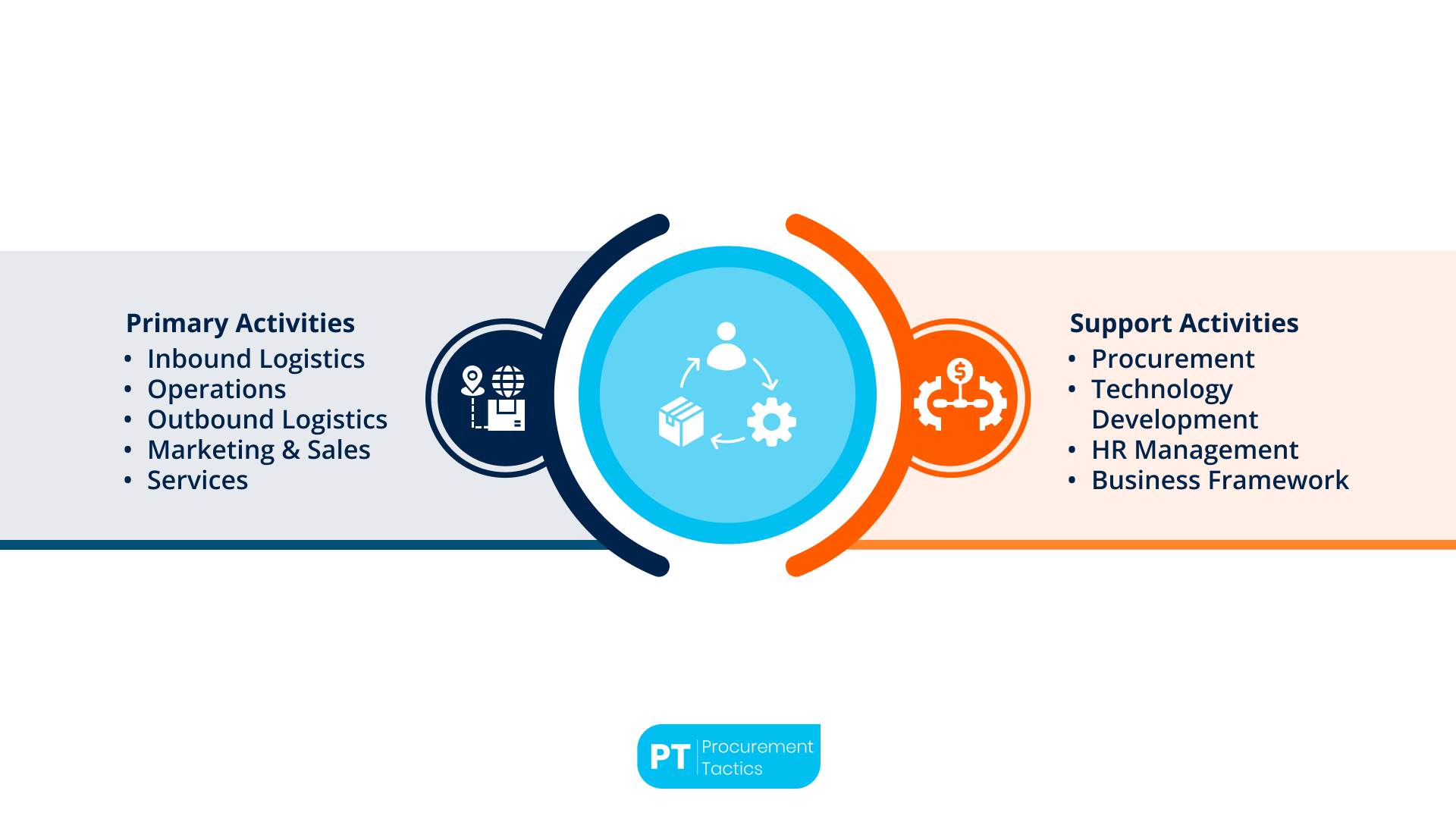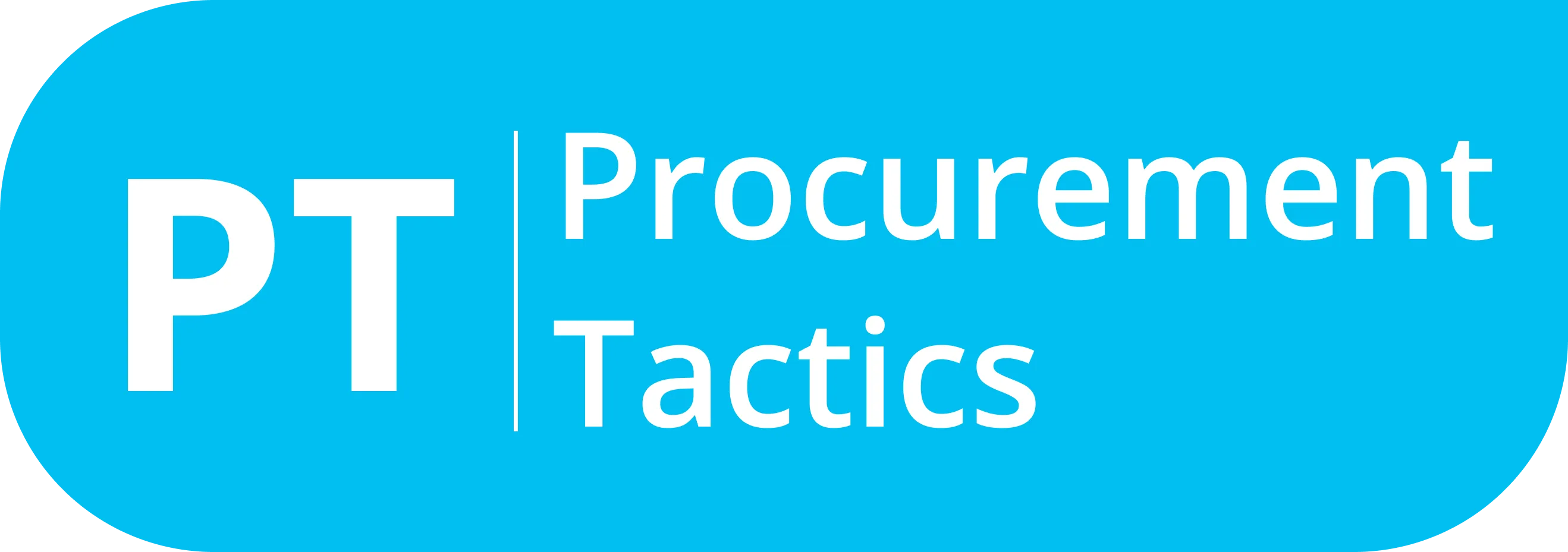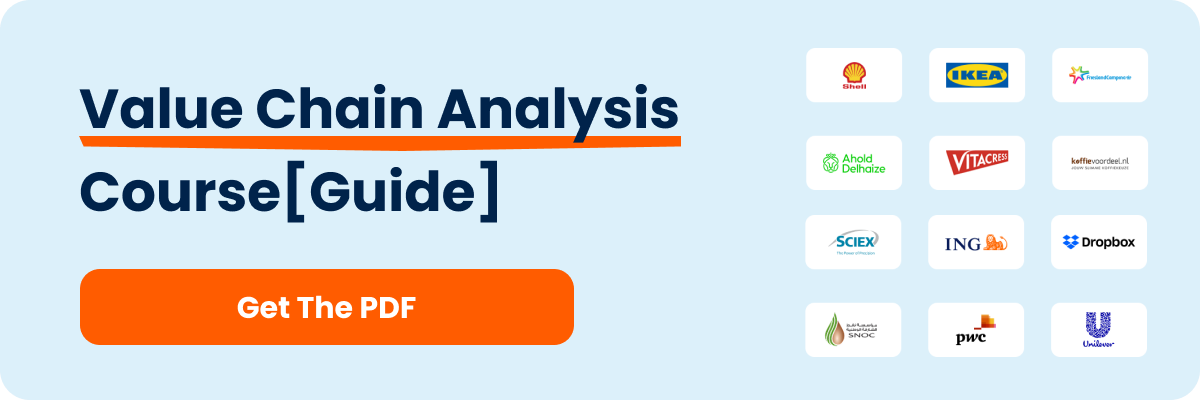Written by Marijn Overvest | Reviewed by Sjoerd Goedhart | Fact Checked by Ruud Emonds | Our editorial policy
The Value Chain — Connecting Procurement to Business Value
What is the value chain?
- The value chain is the entire process companies follow to take a product or service from the idea stage to its final use.
- The value chain seeks to help companies understand the steps involved in creating and delivering a product or service.
- Primary activities are those that are directly involved in the creation, selling, and after-sale services. Support activities are those that indirectly help the primary activities by providing what they need to create the product.
What is the Value Chain?
The value chain is the whole process companies undertake to bring a product or service from conception to end use.
It is a concept introduced by Michael Porter in his 1985 book Competitive Advantage, which seeks to help companies understand the steps involved in creating and delivering a product or service.
The value chain is like a product’s journey from idea to the customer. It covers design, production, marketing, distribution, and the final sale.
The Two Categories of The Value Chain Process

1. Primary Activities
The primary activities are those that are involved in product creation, selling, and services rendered after sales. In this context, they include:
- Inbound Logistics: This involves bringing raw materials into the business.
- Operations: This refers to turning raw materials into finished products.
- Outbound Logistics: This includes sending finished products to customers.
- Marketing and Sales: This focuses on promoting and selling products to customers.
- Services: This covers helping customers after the sale to ensure satisfaction.
2. Support Activities
Support activities are the behind-the-scenes functions that ensure the primary activities have everything they need to create the product. These activities may not directly produce the product or service, but they form the backbone of ensuring everything operates smoothly and effectively. These include:
- Procurement Process: It is a seven-step method used to buy goods, services, or works from suppliers efficiently.
- Technology Development: This involves the creation of new tools and methods to improve processes and products.
- Human Resource Management: This covers the management of employees through hiring, training, and workforce organization.
- Business Framework: This is the structure, financial systems, and operations to keep the company running smoothly.
Why Breaking Down the Process Matters for Procurement
Breaking down the process helps companies stay competitive by improving operations and adding value at each stage. It’s not just about cutting costs, it’s about enhancing the product or service.
For procurement, this analysis saves money and streamlines operations, while uncovering new or eco-friendly materials customers value. It also helps procurement professionals make better supplier choices based on quality, price, and creativity.
This approach encourages company-wide teamwork, aligning buying strategies with business goals. It opens up opportunities to use technology and improve processes.
Ultimately, breaking down the value chain makes procurement a key player in company success, boosting customer offerings and increasing profits.
Why Value Chain Analysis Matters in Procurement
Value Chain Analysis, or VCA, is how businesses examine each step of work to identify ways to improve them. Rather than asking the question, “What can we cut?”, VCA questions, “How can we do this better?” It is not about cost cutting but rather the understanding of the value that every part brings in.
VCA helps organizations identify waste and enhance processes. An analysis of the value chain allows businesses to be more valuable to their customers and stay ahead of competitors, either through waste cutting, the use of new technology, or outsourcing tasks. It indicates how to make operations smarter and different.
VCA also examines how different parts of the business are connected because whatever change is made in one can affect others. Companies that take a more holistic approach to VCA can achieve enduring changes in both efficiency and competitiveness.
Conclusion
The value chain is an important framework that connects every stage of product or service development from conception to delivery. Business processes, particularly the procurement process, can cut out waste and add value by optimizing both primary and support activities.
Value Chain Analysis improves each step to ensure the final product or service delivers the highest possible value to customers. This helps procurement professionals make smarter decisions, choose better suppliers, and align closely with business goals toward long-term efficiency, competitiveness, and profitability.
Frequentlyasked questions
What is the value chain?
The value chain is the whole process companies undertake to bring a product or service from conception to end use.
What are the two categories of the value chain?
The two categories of the value chain are primary activities and support activities. Primary activities are those involved in the product, selling, and services provided after sales. Support activities are those that indirectly help the primary activities by providing what they need to create the product.
Why is breaking down the value chain process important for procurement?
Breaking down the value chain is important for procurement because it helps understand each step in the supply process. This way, procurement professionals can find ways to save money, improve efficiency, or find better materials, including more eco-friendly ones. This process helps make smarter choices for suppliers and ensures the company stays competitive.
About the author
My name is Marijn Overvest, I’m the founder of Procurement Tactics. I have a deep passion for procurement, and I’ve upskilled over 200 procurement teams from all over the world. When I’m not working, I love running and cycling.





